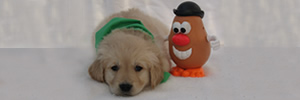What is “Crate Training”?
What is “Crate Training”?
Crate Training is a very effective way to “potty train” your new Golden Retriever puppy. In fact, we highly recommend crate training as the most effective way to “potty train” your puppy. Our puppies will go to their new homes mostly potty trained. However keep in mind during the acclimation period your puppy’s stools may become loosened because of stress, therefore affecting his ability to “hold his potty”. We absolutely do NOT recommend scolding your puppy if he has an accident. The best and most effective way to train your puppy (to do anything) is by POSITIVE REINFORCEMENT! This can be accomplished through treats and praise. Your voice is your greatest training tool! When (crate) training your dog, always use the same command, for example: “go potty” or “potty time” etc. Be sure you are consistent in your use of words so as not to confuse your puppy. If children or other adults are “commanding” your puppy, make sure they know the “correct command word”. Always use praise after she does her business- this is positive reinforcement.
Dogs instinctively will not eliminate in the same area as where they sleep. This is very unnatural and counter to the way they are wired. This is why crate training is so effective. As long as the crate is only big enough for the puppy to lie down and sleep (AND NOTHING ELSE, except for drinking water) he will hold his potty for as long as he is physically capable. Small puppies should not be expected to hold their bowels for longer than 4 hours at a time. As they grow older the holding time will increase. Keep in mind when we say “small puppy” we mean younger than 3-4 months old. A dog is technically a “puppy” for the first 18-24 months of his life. As a rule of thumb, a puppy will need to relieve himself every 2-4 hours until they are at least 6 months of age. Puppies will generally defecate 5-6 times a day and urinate even more frequently. You will need to get up during the night to take your puppy out. An easy way to figure out how many hours a puppy can be expected to control their bladder is to take the puppy’s age in months and add 1. For example, a 4 month old puppy will need to go out every 5 hours.
At first your puppy will not want to be in his crate. He will demonstrate this by crying and whining or barking excessively. As long as all of his needs are met before hand (food, water, potty, attention), he will be fine; no matter how much he doesn’t like being in there. A rule of thumb when crate training is, if your eyes can not be on your puppy, then put him in his crate. This will prevent him from having an “accident” on your carpet. Remember, it’s about preventing the “bad” behavior in the first place.
If you are buying a crate for the first time, we recommend getting a large one that can be partitioned off. If the crate doesn’t already come with the equipment to partition it off then put a box or something dog-safe, yet big enough to leave just enough room for sleeping. As he grows bigger, (and Goldens grow quickly), you will adjust his sleeping space to accommodate his size. If you start out with a crate too large for your small puppy, he will sleep in one portion of the crate and do his business in the other portion of it. Not so nice when you’re the one cleaning it up. If your puppy was shipped to you, then you have already purchased a crate for his flight home. This crate will be plenty adequate for his crate (potty) training.
When it is potty time, make sure not to make it playtime. This will speed up the process in the future when you take her out to do her business, right before bedtime on a cold, snowy night! You will be thankful that “potty time” means potty time and not playtime!
There are three things that will cause your dog to want to eliminate; 1- physical activity (playing, running, walking, training etc.) 2- just after a nap (puppies sleep between 15-20 hours a day. They are growing so fast they need the rest) 3- eating and drinking. These are your warning signs that your puppy will need to eliminate. Be on alert- remember, prevention is better than correction. Puppies have such short attention spans that correction/scolding rarely ever works.
Over time, your puppy’s crate may become his “safe place” where he will want to go to get away (from kids, visitors, other dogs, etc.). To encourage him to like his crate, reward him with a small treat each time he goes into it. This will condition him to really love it! To create a cozy den-like environment, you may cover the crate with a towel or blanket; just be sure to leave plenty of openings for ventilation.
Last but not least- just a word from experience, most of the time your puppy will first look for a spot to urinate, then find a different spot to do the big stuff; I have no idea why. Just be patient and make sure she is really done.
So these are the basic steps to crate training. Let’s review:
1- Start out with the proper size crate
2- Have water accessible from inside crate
3- Make sure puppy’s needs are met before crating him
4- When your eyes are off puppy- put him in crate to eliminate accidents
5- Try to ignore his whining, because you know his needs are met and he’s okay
6- Potty time is potty time- not playtime
7- Be consistent in your “potty” command- use it EVERY time
8- When business is complete- use your voice and/or a treat for POSITIVE REINFORCEMENT
9- Remember the 3 things that will activate your puppy’s bowels
10- When they “go”, make sure they are really done








